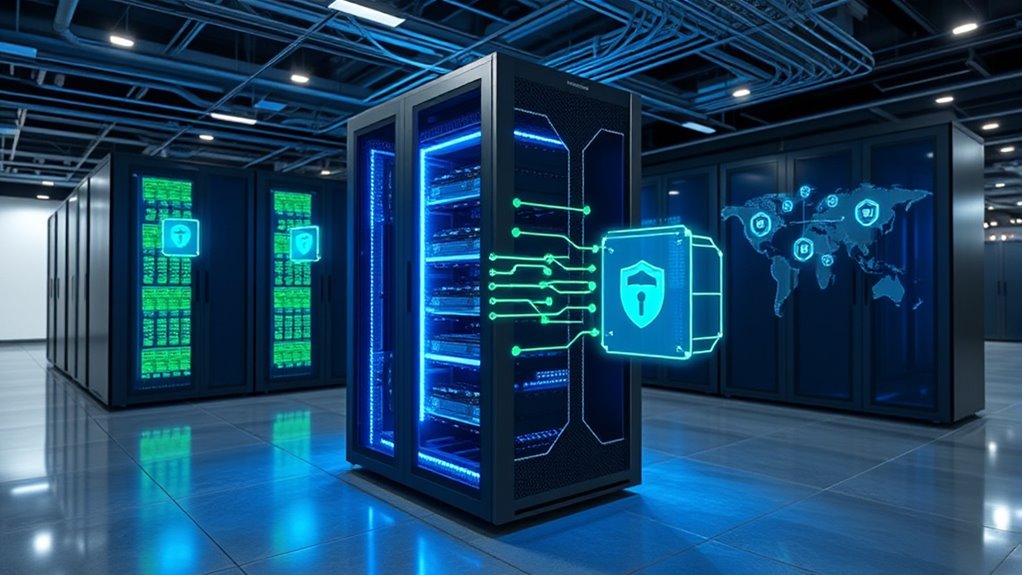AI can boost your edge device security by offering real-time threat detection, automated incident responses, and adaptive protection tailored to distributed networks. It continuously monitors activity to identify anomalies and responds quickly to minimize risks. By integrating AI with edge infrastructure, you can safeguard sensitive data, automate vulnerability checks, and enhance compliance. Keep exploring how AI’s intelligent defense mechanisms can create a more resilient, secure edge environment for your needs.
Key Takeaways
- AI monitors real-time network activity on edge devices to detect and respond to cyber threats instantly.
- Autonomous AI-driven threat detection and playbooks enable proactive security management at the edge.
- Local AI processing minimizes data transfer, preserving privacy and reducing risks associated with cloud dependencies.
- Integration with 5G enhances low-latency, high-speed security responses directly at edge nodes.
- AI automates vulnerability assessments and policy enforcement, strengthening security across distributed edge infrastructure.

As edge computing devices become more integral to critical operations, securing these distributed systems is more important than ever. AI-driven threat detection and response play a crucial role in this effort. With AI, you can monitor network activity in real time, quickly spotting unusual patterns that could indicate cyber threats. Unlike manual methods, AI responds instantly, analyzing risks and taking action before damage occurs, greatly shrinking the window of vulnerability. Continuous examination and predictive analytics at the edge allow AI to foresee potential attacks and proactively mitigate risks, preventing breaches before they happen. Automated playbooks generated by AI enable autonomous, smarter threat responses at the edge, streamlining security workflows and reducing the need for human intervention. When paired with visualization tools, AI enhances your understanding of multi-stage attacks, allowing for rapid reactions and more effective incident management.
Integrating AI into edge computing infrastructure simplifies security management across distributed networks. AI-powered cybersecurity tools are closely linked with virtualization and automation, making it easier to oversee complex edge environments. Companies like AI EdgeLabs support containerized platforms such as Docker and Kubernetes, providing AI-driven vulnerability management that keeps these environments secure. Developing AI security agents for Security Operations Centers (SOCs) and implementing Zero Trust models embed AI deeper into your security framework, ensuring continuous validation and minimal trust zones. Partnerships between AI security firms and edge infrastructure providers strengthen your security ecosystems, boosting operational resilience. AI-powered orchestration platforms automate detection, prevention, and compliance processes across multi-cloud and edge environments, reducing manual effort and improving response times. Additionally, the use of electric heated mattress pads demonstrates how modern safety features and energy-efficient technology can be safely incorporated into everyday products, highlighting the importance of ongoing safety assessments in evolving tech environments. Incorporating cybersecurity best practices further enhances the robustness of these systems against emerging threats. Leveraging entertainment and parks environments for testing security innovations can also provide unique insights into user behavior and system vulnerabilities.
At the same time, edge computing enhances data privacy by supporting decentralized processing. Instead of transferring sensitive data to centralized clouds, AI models at the edge analyze data locally, enforcing security policies right where the data resides. This approach minimizes exposure and reduces risks associated with weak connectivity or cloud dependencies. Autonomous local AI detects anomalies onsite, preserving privacy by avoiding raw data transmission to the cloud. The fusion of edge AI with 5G networks further boosts privacy and security, providing low-latency, high-speed data management essential for sensitive applications like healthcare. The rapid expansion of 5G connectivity by 2025 will enable more secure, real-time AI security at edge nodes, powering critical sectors such as manufacturing, autonomous vehicles, and remote medicine. Enhanced bandwidth and speed allow AI algorithms to process complex threat data streams efficiently, maintaining reliable security even in distributed, resource-constrained environments. Incorporating security automation enables real-time responses that adapt to evolving threats and reduce manual oversight.
AI-driven security solutions also facilitate compliance and risk management. They automate risk assessments, continuously monitor for vulnerabilities, and enforce security policies locally. By integrating AI into edge devices, you ensure a proactive, adaptive defense system that keeps pace with evolving threats, safeguards sensitive data, and maintains operational resilience in a rapidly connected world.
Frequently Asked Questions
How Does AI Adapt to Evolving Security Threats on Edge Devices?
You want to know how AI adapts to evolving security threats. It does this by continuously learning from new data and updating its security protocols in real-time. AI detects and responds to threats faster than traditional methods, adjusting its algorithms as threats change. This ongoing learning process helps you stay ahead of cyberattacks, ensuring your edge devices remain protected against emerging vulnerabilities and sophisticated threats.
What Are the Privacy Implications of AI Monitoring Edge Device Data?
You need to contemplate the privacy implications of AI monitoring edge device data. AI systems can gather sensitive personal and biometric information, raising concerns about data security and user consent. Without proper safeguards, this data could be misused or exposed. Ensuring transparency, obtaining explicit consent, and following privacy regulations like GDPR are essential. Local data processing and robust security measures help protect privacy while allowing AI to enhance monitoring capabilities.
Can AI Prevent Physical Tampering of Edge Hardware?
Think of your edge device as a treasure chest, vulnerable to thieves trying to pry it open. AI acts like vigilant guards, detecting suspicious movements and alerting you instantly. While AI can recognize tampering attempts and trigger countermeasures, it can’t physically prevent someone from breaking in. Still, it substantially enhances your defenses by swift detection and response, making it much harder for tampering to succeed unnoticed.
How Does AI Balance Security and Energy Consumption on Edge Devices?
You wonder how AI balances security and energy use on edge devices. AI optimizes power by managing device activity and running security tasks only when necessary. It processes data locally, reducing energy-intensive transmissions and improving response times. AI-driven monitoring detects threats efficiently, while smart updates and device profiling minimize unnecessary energy drain. This balance guarantees your edge devices stay secure without compromising energy efficiency or performance.
What Are the Cost Implications of Implementing AI Security Solutions?
You’ll find that implementing AI security solutions involves significant upfront costs for infrastructure, devices, and integration. However, these investments can reduce ongoing expenses by cutting bandwidth use, lowering cloud resource needs, and minimizing security risks. Over time, you’ll benefit from long-term savings through increased uptime and fewer breaches. While initial costs are higher, the enhanced security and efficiency offered by AI at the edge can lead to substantial cost benefits.
Conclusion
As you harness AI to shield your edge devices, you’re building a digital fortress at the frontier of technology. Imagine AI as an vigilant guardian, constantly watching over your network like a lighthouse guiding ships safely through stormy seas. With these intelligent defenses, you turn your edge devices into resilient sentinels, ready to thwart threats before they breach your gates. Embrace this AI-powered armor, and watch your security landscape transform into an unbreakable, shining shield.











